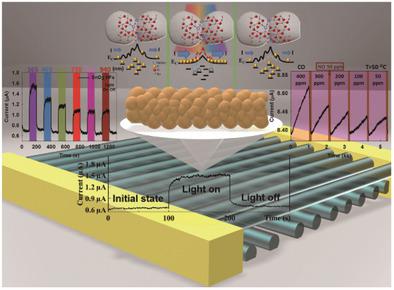当前位置:
X-MOL 学术
›
Glob. Chall.
›
论文详情
Our official English website, www.x-mol.net, welcomes your feedback! (Note: you will need to create a separate account there.)
Enhancement in the Detection Ability of Metal Oxide Sensors Using Defect‐Rich Polycrystalline Nanofiber Devices
Global Challenges ( IF 4.9 ) Pub Date : 2020-09-28 , DOI: 10.1002/gch2.202000041 Chun‐Yen Lai, Yu‐Ting Lin, Hung‐Kun Hsu, Ding‐Yeong Wang, Wen‐Wei Wu, Ping‐Hung Yeh
Global Challenges ( IF 4.9 ) Pub Date : 2020-09-28 , DOI: 10.1002/gch2.202000041 Chun‐Yen Lai, Yu‐Ting Lin, Hung‐Kun Hsu, Ding‐Yeong Wang, Wen‐Wei Wu, Ping‐Hung Yeh

|
The development of SnO2 and TiO2 polycrystalline nanofiber devices (PNFDs) has been widely researched as a method of protecting humans from household air pollution. PNFDs have three significant advantages. The nanofibers before the annealing process are polymer‐rich materials, which can be used as particulate material (PM) filters. The multiporous nanofibers fabricated by the annealing process have numerous defects that can serve as generation‐recombination centers for electron–hole pairs, enabling the PNFDs to serve as multiple‐wavelength light (from 365 to 940 nm) detectors. Lastly, the numerous surface/interface defects can drastically enhance the toxic gas detection ability. The toxic gas detection range of PNFDs for CO(g) and NO(g) is from 400 to 50 ppm and 400 to 50 ppb, respectively. Quick response times and recovery properties are key parameters for commercial applications. The recovery time of NO(g) detection can be improved from 1 ks to 40 s and the PNFD operating temperature lowered to 50 °C. These results indicate that SnO2 and TiO2 PNFDs have good potential for commercialization and use as toxic gas and photon sensors in daily lives.
中文翻译:

使用富含缺陷的多晶纳米纤维设备增强金属氧化物传感器的检测能力
SnO 2和TiO 2多晶纳米纤维器件(PNFDs)的开发已被广泛研究作为保护人类免受家庭空气污染的一种方法。PNFD具有三大优势。退火过程之前的纳米纤维是富含聚合物的材料,可用作颗粒材料(PM)过滤器。通过退火工艺制造的多孔纳米纤维具有许多缺陷,可以用作电子-空穴对的生成复合中心,从而使PNFD可以用作多波长光(365至940 nm)探测器。最后,大量的表面/界面缺陷可以大大提高有毒气体的检测能力。PNFDs对CO (g)和NO (g)的有毒气体检测范围分别为400至50 ppm和400至50 ppb。快速响应时间和恢复特性是商业应用的关键参数。NO (g)检测的恢复时间可以从1 ks缩短到40 s,PNFD的工作温度降低到50 ° C。这些结果表明SnO 2和TiO 2 PNFD具有很好的商业化潜力,并可用作有毒气体和日常生活中的光子传感器。
更新日期:2020-11-03
中文翻译:

使用富含缺陷的多晶纳米纤维设备增强金属氧化物传感器的检测能力
SnO 2和TiO 2多晶纳米纤维器件(PNFDs)的开发已被广泛研究作为保护人类免受家庭空气污染的一种方法。PNFD具有三大优势。退火过程之前的纳米纤维是富含聚合物的材料,可用作颗粒材料(PM)过滤器。通过退火工艺制造的多孔纳米纤维具有许多缺陷,可以用作电子-空穴对的生成复合中心,从而使PNFD可以用作多波长光(365至940 nm)探测器。最后,大量的表面/界面缺陷可以大大提高有毒气体的检测能力。PNFDs对CO (g)和NO (g)的有毒气体检测范围分别为400至50 ppm和400至50 ppb。快速响应时间和恢复特性是商业应用的关键参数。NO (g)检测的恢复时间可以从1 ks缩短到40 s,PNFD的工作温度降低到50 ° C。这些结果表明SnO 2和TiO 2 PNFD具有很好的商业化潜力,并可用作有毒气体和日常生活中的光子传感器。



























 京公网安备 11010802027423号
京公网安备 11010802027423号